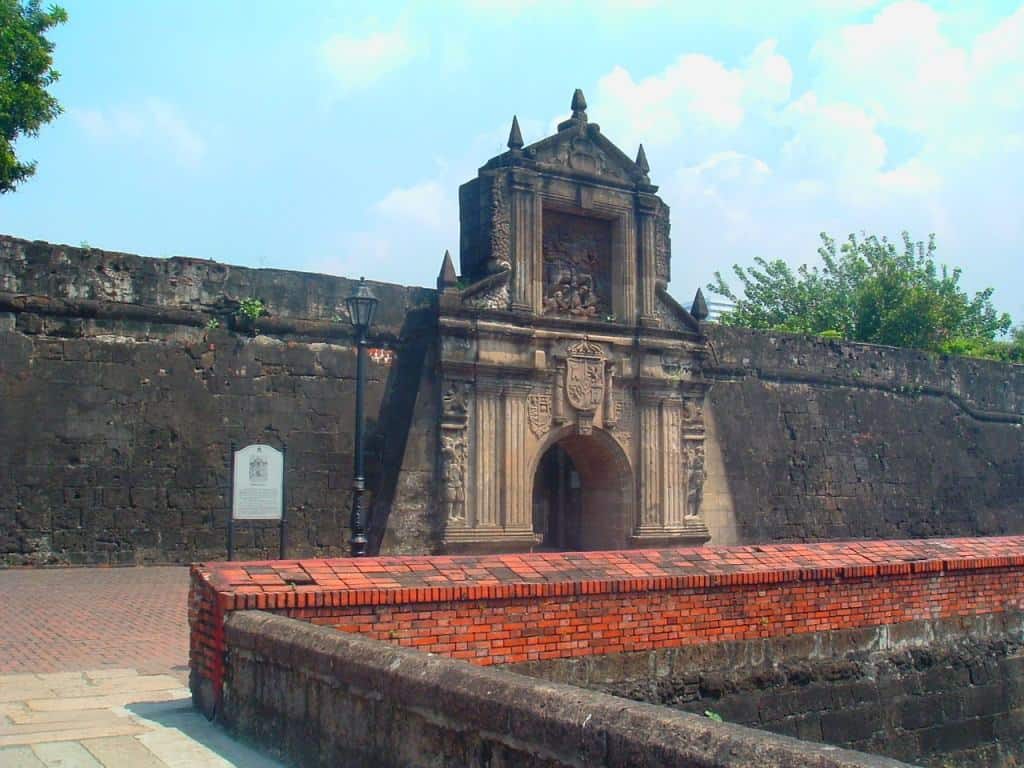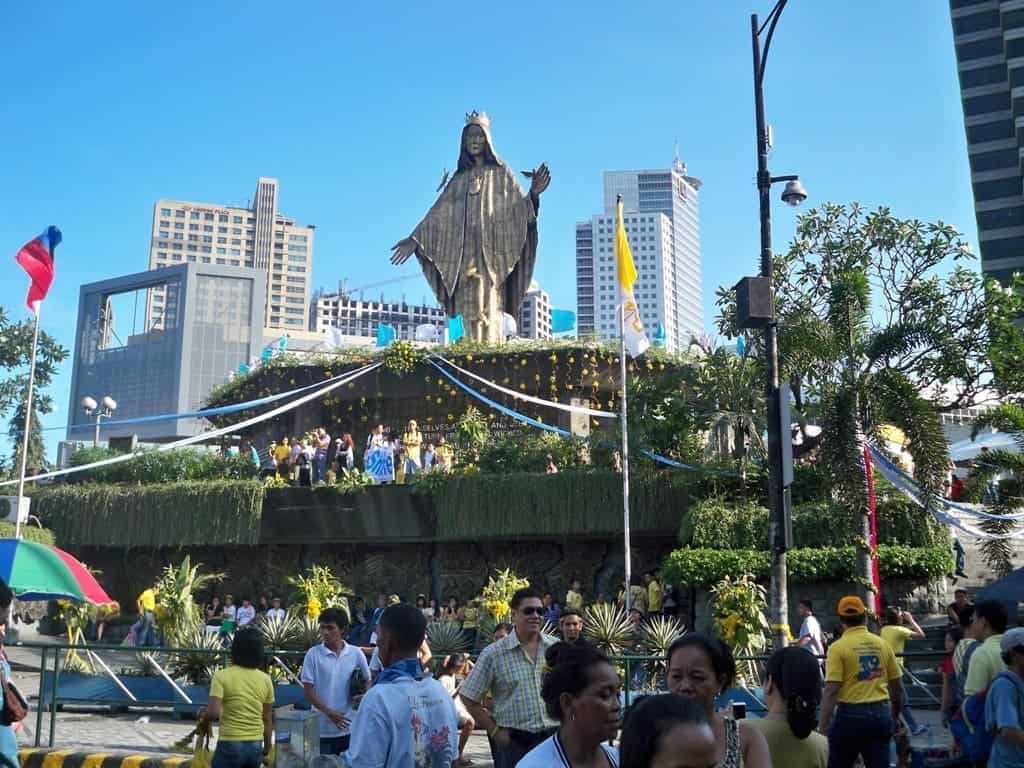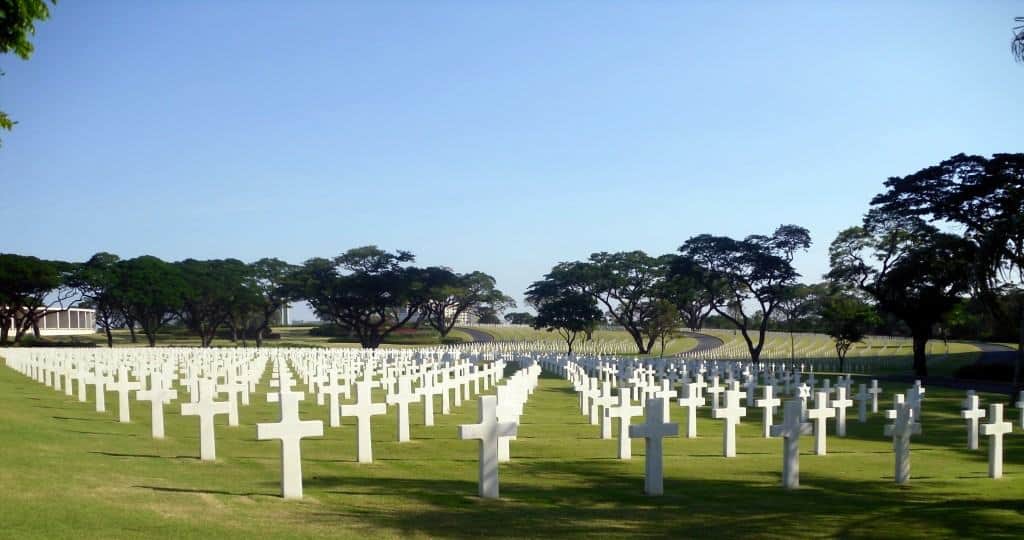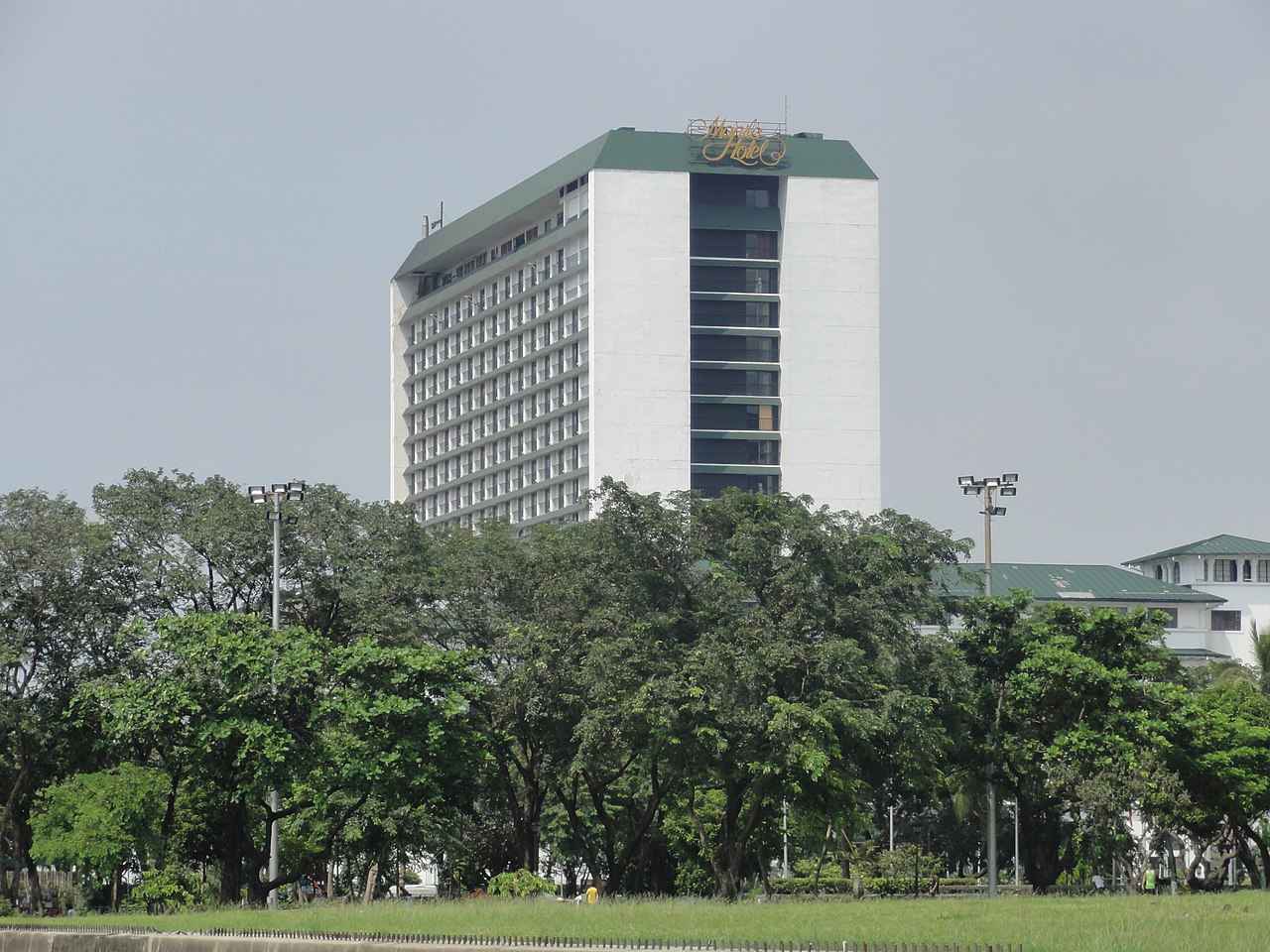Contents
1. Rizal Park
Going for a historic trip around the metro will not be complete without visiting Rizal Park, formerly known as Luneta. Rizal Park is located along Roxas Boulevard, and situated by the Manila Bay,
It is recognized as one of the largest urban parks in all of Asia and features some of the most important events in the history of the Philippines, one of which was the execution of national hero, Dr. Jose Rizal on December 30, 1896. The urban park was renamed Rizal Park in his honor.
Built in 1913, the monument of Rizal, made of bronze and granite, is the park’s centerpiece and among the most famous sculptural landmarks in the Philippines. It is important to note that the monument does not only feature the statue of the revered hero, but his remains are also in there. Visiting dignitaries are almost always expected to lay a wreath at the monument.
The exact place of Dr. Jose Rizal’s execution is just near the monument. You will see sculptures of Rizal, along with Spanish soldiers, depicting the momentous event when Rizal was executed, which ultimately sparked the Philippine Revolution against Spain, on December 30, 1898.
Other than Jose Rizal, other national heroes and significant figures in Philippine history are honored in the Rizal Park. Filipino priests Mariano Gómez, José Burgos, and Jacinto Zamora, collectively known as Gomburza, were publicly executed at Luneta as well, on February 17, 1872. They were garrotted, igniting rage among the Filipinos in the late 19th Century. Jose Rizal’s revolutionary novels Noli Me Tangere, and its follow-up El Filibusterismo, were in memory of the Gomburza.
Another statue found in Rizal Park is that of Lapu-Lapu’s, regarded as the country’s first hero. Rising 40 feet high, Lapu-Lapu’s monument can be easily spotted. He was a native Visayan chieftain in Mactan, Cebu, and historically known to be the first ever Filipino to resist Spanish colonization, leading the battle against the Spaniards led by Ferdinand Magellan, the Portuguese captain, in 1521.
Within Rizal Park, on Roxas Boulevard, situated right in front of the Rizal Monument, is also the famous Kilometer Zero (KM 0). It serves as the basis and point of origin from Manila to different cities/ provinces in the Philippines.
Just a walk away from Kilometer Zero is the the Independence Flagpole, also in front of the Rizal Monument. The Independence Flagpole is the tallest flagpole in the Philippines, standing 150 feet tall, or 46 meters. It also the site where the Philippines’ full independence was proclaimed under the authority of United States’ President, Harry S. Truman.
Other significant features and tourist attractions of Rizal Park are that of the La Madre Filipina statue, which depicts Filipina motherhood; Musical Dancing Fountain, famously known as the biggest dancing fountain in the entire Philippines, boasting of a show with fireballs, waters skyrocketing up to 80 feet high, water rockets exploding, and a peacock spray water.
There’s also the Noli me Tangere Garden, featuring the Heidelberg fountain, donated by Germany to signify Filipino-German friendship. The famous fountain was where Dr. Jose Rizal used to drink during his stay in Germany.
Also within Rizal Park is an open-air auditorium, where free performances, like theater, dance, cinema, and musical performances, are given by the National Parks Development Committee, Department of Tourism and the National Broadcasting Network. The auditorium is designed by National artist for architecture, Leandro Locsin.
There’s also the Quirino Grandstand, relief map of the Philippines, National Library of the Philippines, National Museum of the Philippines, Filipino-Korean Soldier Monument, The Flower Clock, Diorama of Rizal’s Martyrdom, Artist’s Haven, Artworks in the Park, and numerous other tourist attractions in Rizal Park. You will no doubt leave the park more educated on Philippine history.
Location: Roxas Boulevard, Ermita, Manila City, Metro Manila – VIEW MAP
2. Intramuros
Intramuros is actually the oldest district in Manila, also known as the “Walled City.” Visiting Intramuros is literally like going back in time during the Spanish colonization as Intramuros is very much preserved, and still heavily influenced by the old Spanish Era. Built in the 16th century, Intramuros is actually the original city of Manila, as well as the Philippine seat of government. It survived numerous attacks from foreign invaders, such as the Netherlands, China, and Portugal, as well as natural disasters.
Centuries-old institutions, such as schools and churches, retained its original location within the walls of the Intramuros. The Colegio de San Juan de Letran, a college established in 1620, is one of them.
Manila Cathedral, also within Intramuros, is the seat of the Roman Catholic Archdiocese of Manila and has been visited by many popes like Pope John Paul II, Pope Paul VI and, most recently, Pope Francis. Manila’s oldest building, the San Agustin Church, is also located in Intramuros. It was built in 1607. San Agustin Church and the Manila Cathedral are the last of the seven Churches that remained in Intramuros.
Intamuros is also home to the famous Fort Santiago, a citadel that guards the old city of Intramuros. Built by Miguel Lopez de Legazpi, a Spanish conquistador, Fort Santiago is the site where Dr. Jose Rizal spent his final days on earth, imprisoned here before executed, and where several lives were lost in its prisons. The triangular fort has bastions on each corner and has a perimeter of 2030 feet.
Today new buildings are found in Intramuros, but it still currently holds the top position as the most visited tourist attraction in Metro Manila, according to the Department of Tourism.

Location: Intramuros, Manila City, Metro Manila – VIEW MAP
3. EDSA Shrine
Located in the center of the two of the busiest roads in the metro—EDSA (Epifanio Delos Santos Avenue) and Ortigas Avenue— The Shrine of Mary, Queen of Peace, or more popularly known as the EDSA SHRINE, is one of the most recent historical spots in Manila as it commemorates two peaceful demonstrations in Philippine history.
The EDSA Shrine was built in 1989 originally to commemorate the People Power Revolution, which put a halt to former President and dictator Ferdinand Marcos’ regime in 1986. The said People Power Revolution was called EDSA 1, which began in 1983 first as a series of non-violent demonstrations which culminated on February 22 to 25, 1986. The participants in the revolution involved two million civilians, as well as religious, political and military groups.
EDSA 1, also referred to as the Yellow Revolution, was headlined worldwide as “the revolution that surprised the world.”
In 2001, the EDSA Shrine became the site for another peaceful revolution to topple a Philippine president, this time, Joseph Estrada, after an aborted impeachment trial. This became known as EDSA II.

Location: Ortigas Center, EDSA corner Ortigas Avenue, Ugong Norte, Quezon City, Metro Manila – VIEW MAP
4. Quiapo Church
Quiapo Church is where the infamous Black Nazarene is housed. Quiapo Church is just the colloquial name of The Minor Basilica of the Black Nazarene, a famous Roman Catholic Latin-rite basilica located in the District of Quiapo in the City of Manila, Philippines.
It is a Baroque Church, with a distinctive façade with Corinthian columns. It was consecrated on February 1, 1988 and conferred the title Basilica Minor of the Nuestro Padre Jesus Nazareno.
The Black Nazarene, which is a carved by a Mexcan artist in what he deemed as the image of Jesus Christ but with dark skin, is claimed by many Catholics to produce miracles when touched. It was in the 17th century when the graven image was brought to the country in a Spanish Galleon.
Today, the Quiapo Church holds a novena every Friday, called “Quiapo Day,” in honor of the Black Nazarene, with hundreds of Filipino Catholics in attendance.
Every year, in January 9, is the Catholic Church’s Feast of the Black Nazarene. During this day, thousands of Catholic devotees line up in a procession that starts at the Quiapo Church and coils around the streets of Manila. The devotees believe that participating in the procession will erase their sins in a year. It is usually an overwhelming sight during this time of the year, a sea of devotees clamoring to touch the Black Nazarene.
The Quiapo Church was built around 1582. Foreign invaders, such as the English, attempted to destroy the Church in 1762. In 1863, an earthquake destroyed Quiapo Church and reconstructed in 1889. In 1928, the Church caught fire and again reconstructed in 1933. In 1984, Architect Jose Maria Zaragoza enlarged the church and revised the design of the lateral walls. The facade and the dome of the Church were retained after the remodeling.
Just outside the Quiapo Church, it is known that some vendors are illegally peddling abortifacients, potions and herbal remedies. The area is also littered with fortune-tellers and albularyos (Pinoy healers).

Location: Quezon Blvd, Manila City, Metro Manila – VIEW MAP
5. Libingan Ng Mga Bayani (Heroes’ Cemetery)
Established in 1947 within Fort Bonifacio, Libingan ng mga Bayani (or Heroes’ Cemetery), is a national cemetery—the resting place for deceased heroes, martyrs, military personnel, with mostly defenders of the Allied Liberation of the Philippines from 1942 to 1945 during World War II. It is the Philippine counterpart to Manila American Cemetery and Memorial.
Libingan ng mgaBayani currently has over 47, 000 buried bodies. This count includes former presidents Diosdado Macapagal, Elpidio Quirino and Carlos P. Garcia, and General Carlos P. Romulo.
A large portion of Libingan ng mga Bayani is dedicated to over 32,000 bodies of military officials who were involved in the historic “Death March,” the infamous forced walk of soldiers from Bataan to Capas, Tarlac, during the World War II.
General Douglas McArthur once visited the place to honor the heroes of the war. His statement “I do not know the dignity of his birth but I know the glory of his death” was imprinted at the main entrance of the cemetery.
It is also notable that the Libingan ng mga Bayani contains the Tomb of the Unknown Soldier, which is a monument built in dedication to the services of an unknown soldier, as well as all soldiers killed in any war.

Location: Taguig City, Metro Manila – VIEW MAP
6. The National Museum of the Philippines
The National Museum, located in the vicinity of Rizal Park, is a government institution that preserves the permanent national collections and operates the National Museum of Fine Arts, National Museum of Anthropology, National Museum of Natural History, and National Planetarium. It also serves as an educational, scientific and cultural institution. Grand and imposing, it used to be the old Legislative Building.
The National Museum was inaugurated in 1926 and housed the Senate, House of Representatives and National Library. Today it is still divided into four museums, with the two major divisions being he National Art Gallery and the Museum of the Filipino People, with a cheap entrance fee (P100).
The Constitutional Convention of 1934 was held here in National Museum, and was the historical site wherein former President Manuel L. Quezon proclaimed himself as the President of the Commonwealth.
National Museum of Fine Arts. Entering here, you will be greeted with the large iconic painting, the Spoliarium, from acclaimed national artist Juan Luna. The painting made its rounds abroad and is widely regarded as one of the world’s best artworks for its raw depiction of the horrors of the Spanish colonization. It still hangs in the “Masters” gallery beside the lobby, next to another masterpiece—Felix Hidalgo’s “La Tragedia de Gobernador Bustamante.” The Spolarium remains to be a major highlight in the National Museum.
Finished and unfinished works of renowned artists, such as Félix Resurrección Hidalgo, Fernando C. Amorsolo, Pablo Amorsolo, Fabian de la Rosa, Jorge Pineda, Ireneo Miranda, and Fabian de la Rosa, also fill the gallery.
The National Museum of the Philippines is open from Tuesday to Sunday, 10 am to 5pm and will no doubt provide you with a deeply enriching knowledge of Filipino art and history.

Location: Taft Ave, Ermita, Manila City, Metro Manila – VIEW MAP
Hours: Tuesday to Sunday, 10 am to 5pm
7. San Juan del Monte Bridge
The San Juan Bridge, also known as The San Juan River Bridge, played a pivotal role in the country during the Spanish and American colonization, serving as the main battleground of the Filipino revolution against the Spaniards in 1986, as well as the Filipino-American War in 1989.
The 40-meter bridge bridge is the boundary between the city of San Juan and Santa Mesa, one of the sixteen (16) areas of Manila, Philippines, connecting he N. Domingo Street in San Juan and Old Santa Mesa Street in Manila.
This iconic San Juan bridge was the exact, literal site where the “first shot” of the revolution happened. It was American soldier Willie Grayson who fired the first gunshot to a Filipino soldier, which sparked the Battle of Manila.
Today, the San Juan Bridge is a major mall in Manila, the SM City Sta. Mesa.
Location: San Juan Bridge, San Juan City, Metro Manila
8. Marikina Shoe Museum
The fact that this shoe museum was built in the country’s shoe capital city, Marikina, is rather appropriate. It is essentially a museum that serves as a storage for the shoes of the Philippine’s biggest personalities. These include the shoes of every Philippine president, vice president, mayors of Marikina, and other politicians.
But the main attraction in the Marikina Shoe Museum is the whopping 700+ pairs of shoes owned by former First Lady Imelda Marcos (wife of deceased president Ferdinand Marcos) from her highly controversial 3,000 shoe collection. Check out all the different shoes that she wore for different occasions—shoes either made in Marikina or abroad. Hanging above the shoe collection is a big portrait of Imelda Marcos, which makes everything look like a Shoe Shrine.
It was also in this museum that the shoe-making pioneer “Kapitan Moy,” or Don Laureano Guevarra, was honoured or his major contribution to the city’s shoe industry.
The Marikina Shoe Museum was planned by then Marikina Mayor Bayani F. Fernando in 1998. Three years later, it opened to the public as the “Footwear Museum of Marikina.” But it was more than a museum that shelves shoes. In the Spanish Colonization Era, it serves as a storage house for weaponry, as well as a detention cell during the war between the United States and the Philippines.
The Shoe Museum is open Mondays to Sundays, from 8 a.m. to 5 p.m., except holidays. The entrance fee is cheap, just P50.
Location: J. P. Rizal St, Marikina City, Metro Manila – VIEW MAP
Hours: Mondays to Sundays, from 8 a.m. to 5 p.m., except holidays.
9. Binondo
Unknown to many, Binondo is actually the world’s oldest Chinatown. It was founded by Spanish Governor Luis Perez Dasmarinas in 1594 to serve the Chinese immigrants that converted to Catholicism.
The district then became the capital of Manila’s market and commerce due to the onslaught of Filipino-Chinese businessmen trading to serve the nearby populated places, such as Intramuros and Tondo.
Binondo Church, where the infamous image of Santo Cristo de Longos (believed by Catholics to produce miraculous healings), was one of the popular landmarks in Binondo. It is also where
Andres Bonifacio, the Filipino revolutionary leader and the first president of the Philippine archipelago, married Gregoria de Jesus.
Binondo is also famous for the kilometre-long Ongpin Street, which is lined with amazing restaurants dating back to the Spanish Era, serving classic Chinese recipes passed down to generations. If you are in the mood for food tipping, you will definitely delight in Binondo,
Although Binondo suffered from nature and man-made destruction, it managed to survive and retain its commercial glory and cultural heritage.
Location: Binondo, Manila City, Metro Manila – VIEW MAP
10. Manila Hotel
The five-star Manila Hotel is the oldest premiere hotel in the country, boasting of an impressive history of clientele: General Douglas McArthur, who was once stayed at the penthouse; former US Presidents Richard Nixon and Lyndon Johnson; Hollywood superstars John Wayne and Marlon Brando; world-renowned performers Sammy Davis, Jr., Michael Jackson The Beatles (John Lennon, Paul McCartney, Ringo Starr and George Harrison); authors Ernest Hemingway and James A. Michener;
The 570-room hotel, which was built in 1909, competes with the beauty of the Malacañang Palace, the official residence of the President of the Philippines, upping its glamour and architectural design, courtesy of the son of the famous Juan Luna—Architect Andres Luna de San Perdro. Its tower, is the tallest hotel tower in the Manila Bay area.
The Manila Hotel also had its share of horrors. In World War II, the hotel was invaded by Japanese troops, who took residence in the hotel. In the duration of the war, the Japanese flag was flown above the walls. And during the Battle for the Liberation of Manila, the hotel was set on fire by the Japanese. Fortunately, the shell of the hotel survived the fire, and the structure was later reconstructed.

Location: Bonifacio Drive, Ermita, Manila City, Metro Manila – VIEW MAP
Note: Aside from the 10 mentioned historical spots in this list, there are also quite a few places in Metro Manila you can explore if you have more time. The Malacañang Palace, the official residence of the Philippine President in Mandaluyong offers a glimpse into the Philippines’ past presidents. You may also want to learn about the mysterious story behind the Sto. Nino in the town of Pandacan; or visit the old Las Piñas Church, or the Las Piñas Bamboo Organ Church, to check the pipe organ made mostly with bamboo pipes. The list is endless.
Helpful articles and blog posts on Historical Tourist Attractions in Manila:
We only recommend writers and blogs that we read regularly and believe will deliver substantial value to our readers. The following is our top picks of articles we think are worth reading for you to get an extensive knowledge of some of the historical tourist spots that we mentioned above.
- “Staycation at Manila Hotel” – by Mrs. MommyHolic
- “Inside National Museum of the Philippines” – by MaxterMind
- “Binondo Food Trip | First Stop: Estero Fast Food!”– by Teta Adventurer
- “The 2-hour Intramuros Do-it-Yourself Tour” – by Lady and her sweet escapes
- “A Family Trip to Marikina City One Fine Day” – by Mommy Practicality
How Did We Do?
Is the article “Top 10 Historical Tourist Attractions in Manila” useful? If so, please share and like this post, as it helps other travelers find information. Many thanks! You can follow us on Twitter or Facebook for further updates!


